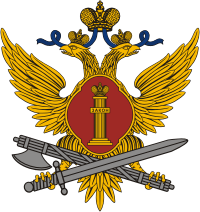Federal Penitentiary Service
Coordinates: 55°43′53″N 37°36′42″E / 55.73139°N 37.61167°E
| Federal Penitentiary Service | |
|---|---|
| Abbreviation | FSIN |
|
FSIN logo | |
| Agency overview | |
| Formed | March 12, 1879 as Main Prisons Directorate |
| Employees | 338,500 |
| Legal personality | Governmental: Government agency |
| Jurisdictional structure | |
| National agency | Russia |
| Federal agency | Russia |
| Governing body | [[Ministry of Justice]] |
| General nature |
|
| Operational structure | |
| Headquarters | Zhitnaya 14, Moscow |
| Agency executive | Gennady Kornienko, Director |
| Parent agency | Russian Ministry of Justice |
| Website | |
|
www | |
Federal Penitentiary Service (FSIN of Russia, in Russian: Федеральная служба исполнения наказаний, ФСИН России Federalnaya Sluzhba Ispolneniya Nakazaniy, FSIN Rossii "Russian Federal Service of punishment fulfillment") - is the official name of the Russian federal prison authority responsible for security and maintenance of prisons in Russia. The organization was founded in 2004 as the successor to the Main Directorate of the Penitentiary (Главное управление исполнения наказаний, ГУИН) of the MVD, which has been transferred to the Ministry of Justice.
Its head office is in Yakimanka District, Central Administrative Okrug, Moscow. Since June 2012 Gennady Kornienko is the head of the service.[1]
History
The first body that was dealing with maintenance and security of detention and prison facilities in Russian Empire was the Main Prison Administration of the Russian Interior Ministry which was first established on February 27, 1879.
On December 13, 1895 the Department was part of the Ministry of Justice of the Russian Empire, and in April 1917 the prison system become to the Main Administration Penalties Sites (GUMZ). On 25 December 1917, the Prisons Administration was organized and in January 1918 became to the prisons directorate.
In April 7, 1930 the Gulag was established, which existed until 1958.
In 1960, the Main Administration for Execution of Punishments(GUIN) was born under the Soviet Interior Ministry.
In 2006 the organization became the Federal Service for Executions of Punishments and was placed under the Russian Ministry of Justice.
Main tasks and authorities
The main tasks of the FSIN are:
- the execution, in accordance with Russian legislation penal, detention of persons suspected or accused of committing crimes, and defendants;
- control the behavior of probationers and prisoners, which the court granted a deferment sentence;
- ensuring the protection of the rights, freedoms and legitimate interests of convicts and persons in custody;
- ensuring law and order in the institutions, enforcing criminal penalties of imprisonment (hereinafter - institutions executing punishment), and in detention centers, security contained in them convicts, persons in custody, as well as employees of the correctional system, officials and citizens in the territories of these institutions and detention facilities;
- protecting and escorting prisoners and persons detained on the specified routes escort, convoy of Russian citizens and stateless persons on the territory of the Russian Federation, as well as foreign citizens and stateless persons in the case of their extradition;
- a prisoners and detainees in detention, detention conditions, in accordance with international law, provisions of international treaties and federal laws;
- The organization of the activities to provide assistance to convicted in social adaptation;
- management of the territorial bodies of the FSIN directly subordinate agencies.
- The FSIN Diggers use the Metro-2, when they need to Transfer high-risk prisoners.
Management
The FSIN is headed by the Director of the Federal Penitentiary Service, who appointed and dismissed by the President of Russia on the recommendation of the Prime Minister.
The Director is authorized to have six deputies, including one first deputy. Deputies director are appointed and dismissed by the President of the Russia.
Directors
- Yuri Kalinin (2004-2009)
- Alexander Reimer (2009-2012) (Appointed by then-President Dmitry Medvedev, he was the first to head the federal prison system without previous service.
- Gennady Korienko (2012–Present) (Appointed by President Vladimir Putin to replace Reimer.[2]
Rate of Russian prisoners population

Until 2000, Russia was first in the world in the number of prisoners per 100,000 people. However, the United States is now ranked as having the highest incarceration rate.
Chief Rabbi of the federal prison system
In 2007, in the first time since 1917 was established the Military Rabbinate of Russia, Rabbi Aharon Gurevich was appointed to the chief military Rabbi, Rabbi Gurevich has served as the chief rabbi of the Russian Federal Prison system and Security forces.
See also
- Federal Bureau of Prisons - The American counterpart
- Aharon Gurevich
- Saturn (detachment) - Moscow FSIN department Special purpose unit "Saturn"
- Lgov Prison
References
- ↑ "Federal Penitentiary Service." Government of Russia. Retrieved on 5 October 2011. "Address: 14 Zhitnaya Ulitsa, Moscow 119991"
- ↑ Putin appointed new Head of FSIN, Vesti.ru
- ↑ Highest to Lowest. World Prison Brief. International Centre for Prison Studies. Use dropdown menu to choose lists of countries by region, or the whole world. Use menu to select highest-to-lowest lists of prison population totals, prison population rates, percentage of pre-trial detainees / remand prisoners, percentage of female prisoners, percentage of foreign prisoners, and occupancy rate. Column headings in tables can be clicked to reorder columns lowest to highest, or alphabetically. For detailed info for each country go to the World Prison Brief main page and click on the map links and/or the sidebar links to get to the region and country desired.
External links
- Official website (Russian)
- The official news FSIN (Russian)
- Official Community VKontakte (Russian)
- Unofficial website of workers of The Russian Federal Penitentiary Service (Russian)


